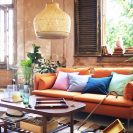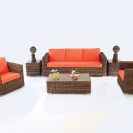The Diwaniya is a uniquely Kuwaiti concept. Traditionally, they serve as venues for social interaction where Kuwaiti men gather to engage in discussions pertinent to their lives. However, we’re also seeing them being used by the women and families of the household. Given the regular attendance of Kuwaiti men at dīwāniyya sessions, this tradition has become an integral aspect of everyday Kuwaiti culture.
Our favorite home textile manufacturer Mastara has joined forces with Euston Design and is offering clients free interior design consultations to help you revamp or redesign your Diwaniya This Ramadan.
Euston Design are known for transforming your personal feelings about space into artistic realizations that match your expectations. They are passionate about providing the most technologically advanced contemporary interior design solutions and will always be “ahead of the curve,” giving clients thoughtful, practical, and inspiring interior design services.
We all have fond memories of diwaniya time and would like to create more magical moments at home. We spoke to Jamal S AlFahham, Mastara’s CEO and Dr Khalid Al Mutawa, Euston Design’s founder to learn why they think diwaniyas are special and how we can improve ours.
“One of my fondest childhood memories centers around the vibrant game nights spent in the diwaniya. It was more than just a physical space; it served as the backdrop for forming strong bonds through spirited card battles, entertaining PlayStation matchups, and traditional board games. These gatherings, filled with merriment and good-natured competition, embodied the essence of my upbringing. The diwaniya was our haven where my friends and I could revel in each other’s company, crafting treasured moments that have remained with me to this day,” Jamal S AlFahham, Mastara CEO explains.
“One of my favorite childhood memories in a diwaniya was during Eid celebrations. The diwaniya, filled with the warmth of family and friends. I remember sitting with my friends and relatives, eagerly waiting for the delicious traditional (homemade) sweets that were being served. The vibes were filled with laughter and joy. Feeling a sense of unity and belonging in the festive atmosphere. It was a time of bonding, happiness, and cherished memories that I will always hold dear,” Dr Khalid Al Mutawa, Euston Design’s founder told us.
Designing the perfect Diwaniya is tricky, it’s crucial to consider utility and ensure that it caters to the needs of its users. Many overlook simple additions that can significantly enhance comfort and functionality. A Diwaniya should be equipped with everything necessary for its intended use, whether for formal gatherings or casual meet-ups. In both scenarios, practicality, connectivity, and comfort should be the core elements. For instance, in a casual Diwaniya, there should be ample, comfortable seating and easily accessible power outlets for devices, creating a relaxed environment where friends can gather. Meanwhile, a formal Diwaniya requires a different approach, focusing on elegant design while still maintaining the essence of hospitality and ease of use. Remembering these small details can transform the Diwaniya experience, making it more welcoming and suited to its purpose.
In a Diwaniya, it’s important to create an environment that fosters camaraderie, relaxation, and social interaction. Here are some elements that Dr Khalid told us to consider:
Comfortable seating: Arrange ample seating arrangements, such as sofas, chairs, or floor cushions, to ensure guests can relax and socialize comfortably.
Refreshments: Offer a variety of refreshments, including tea, coffee, soft drinks, and water. You can also include traditional beverages, dates, and snacks to add a cultural touch to the gathering.
Entertainment: Provide entertainment options such as board games, cards, or video games, depending on the preferences of your guests. You could also have a television for watching sports events or movies.
Decorations: Decorate the diwaniya with decorations and accessories that reflect the occasion or theme of the gathering. This could include painting arts, flowers, or thematic decor items.
Cultural elements: Incorporate cultural elements such as coffee corner and/or Arabic coffee (Dallah) shelves.
Inviting ambiance: Pay attention to lighting and ambiance to create a welcoming atmosphere.
Outdoor space: If possible, utilize any outdoor space available to expand the Diwaniya area. This could be a garden, patio, or balcony where guests can enjoy fresh air and nature, especially during pleasant weather.

By considering these elements, you can create a welcoming and enjoyable environment in your diwaniya for gatherings with family and friends. “My favorite aspect of Diwaniyas is their role as a communal space that brings people together. Growing up in Kuwait, Diwaniyas were not just rooms; they were where bonds were strengthened, and traditions were passed down. They epitomize the spirit of community and hospitality that is deeply rooted in Kuwaiti culture,” Jamal S AlFahham, tells us.
Collaborating with Euston Design was a natural choice for Mastara. The pair share values in enhancing living spaces and their commitment to quality and creativity makes this collaboration a perfect fit. The experience has been incredibly rewarding for both parties, especially seeing the positive impact on customers’ lives.
“My favorite part [of the collaboration] has been the mutual exchange of ideas and the fusion of our strengths to revamp Diwaniyas, making them ready for Ramadan in ways that resonate with modern lifestyles while preserving our cherished traditions,” Jamal S AlFahham enthuses.
While we love the look and feel of the classic Diwaniya, they don’t always fit today’s aesthetics. Designing a modern diwaniya while preserving important cultural elements is both achievable and meaningful. Here are some suggestions that Dr. Khalid gave us on how to accomplish this:
Blend Traditional and Modern Aesthetics:
Incorporate traditional elements such as Arabic calligraphy, geometric patterns, or cultural artifacts into the modern design scheme. Use modern furniture with clean lines and neutral colors as a backdrop for showcasing traditional textiles, artwork, or decorative pieces.
Embrace Cultural Colors and Textures:
Infuse the space with rich, warm colors inspired by traditional Middle Eastern palettes, such as deep blues, earthy browns, and vibrant reds. Integrate traditional textiles like embroidered fabrics, plush carpets, or intricately patterned rugs to add texture and visual interest to the modern decor.
Create a Multifunctional Space:
Design the Diwaniya to serve multiple purposes, such as a lounge area for socializing, a dining area for sharing meals, and a space for cultural activities or gatherings.
Incorporate flexible furniture arrangements and versatile storage solutions to accommodate different activities and needs.
Focus on Comfort and Hospitality:
Prioritize comfort by selecting plush seating options like oversized sofas, and floor cushions that encourage relaxation and conversation. Enhance the hospitality of the space with amenities such as a refreshment station stocked with traditional beverages, a designated area for serving sweets or snacks, and comfortable seating areas conducive to socializing.
Celebrate Cultural Heritage:
Showcase cultural heritage through artwork, photographs, or displays that highlight significant aspects of Middle Eastern culture, history, and traditions. Incorporate elements like traditional lanterns, ornate mirrors, or carved wooden screens as focal points that pay homage to cultural heritage while complementing modern design elements.

While we all wish we had lots of room for the perfect social space, we’re not all that lucky. Creating a diwaniya-like space in smaller homes or apartments requires thoughtful planning and creative design solutions to maximize the available space while maintaining the essence of a traditional diwaniya. Here are some of Dr.Khalid’s ideas:
Multi-Functional Furniture:
Use multi-functional furniture pieces that serve multiple purposes. For example, choose a sofa bed or a daybed that can double as seating during the day and a sleeping area at night.
Consider ottomans or storage benches that provide seating as well as hidden storage space for blankets, cushions, or other items.
Flexible Seating Arrangements:
Opt for flexible seating arrangements that can easily be reconfigured to accommodate different activities and group sizes. This could include folding chairs, stackable stools, or floor cushions that can be easily moved around as needed.
Use lightweight and portable furniture that can be easily rearranged or stored away when not in use to free up space.
Utilize Vertical Space:
Maximize vertical space by incorporating wall-mounted shelves, bookcases, or storage units to display decorative items, books, or personal belongings.
Consider installing floating shelves or wall-mounted desks to create functional work or display areas without taking up valuable floor space.
Strategic Use of Mirrors:
Use mirrors strategically to create the illusion of a larger space and enhance natural light. Place mirrors opposite windows or in areas where they can reflect light and visually expand the room.
Consider decorative mirrors with ornate frames or geometric designs to add visual interest and reflect cultural elements.
Lighting Design:
Pay attention to lighting design to create ambiance and enhance the mood of the space. Use a combination of overhead lighting, task lighting, and accent lighting to illuminate different areas and highlight key features.
Incorporate soft, warm lighting sources such as floor lamps, table lamps, or string lights to create a cozy and inviting atmosphere reminiscent of a traditional diwaniya.
Create Intimate Zones:
Divide the space into distinct zones or areas to serve different purposes while maintaining an open and cohesive layout. For example, designate a corner for lounging and socializing, a dining area for meals, and a quiet nook for reading or relaxation.
Use area rugs, room dividers, or decorative screens to delineate separate zones and add visual interest to the space.
Minimalist Decor with Cultural Accents:
Adopt a minimalist approach to decor to prevent the space from feeling cluttered or overcrowded. Choose furniture and accessories with clean lines and simple designs to create a modern and streamlined look.
Incorporate cultural accents and elements inspired by traditional Diwaniyas, such as colorful textiles, patterned rugs, decorative cushions, or artwork that reflects your cultural heritage.
Mastara is the first and only bilingual app and website in the region to offer customized sofas, curtains and blinds online. Book a free consultation today at www.mastara.me/appointment or Whatsapp 9092 5757. You can also contact Euston Design directly by calling 9872 6060 or 2220 0157, email Info@eustondesign.com, or visit their office at Alraya Tower 2 – 17th floor, Sharq, Kuwait.








